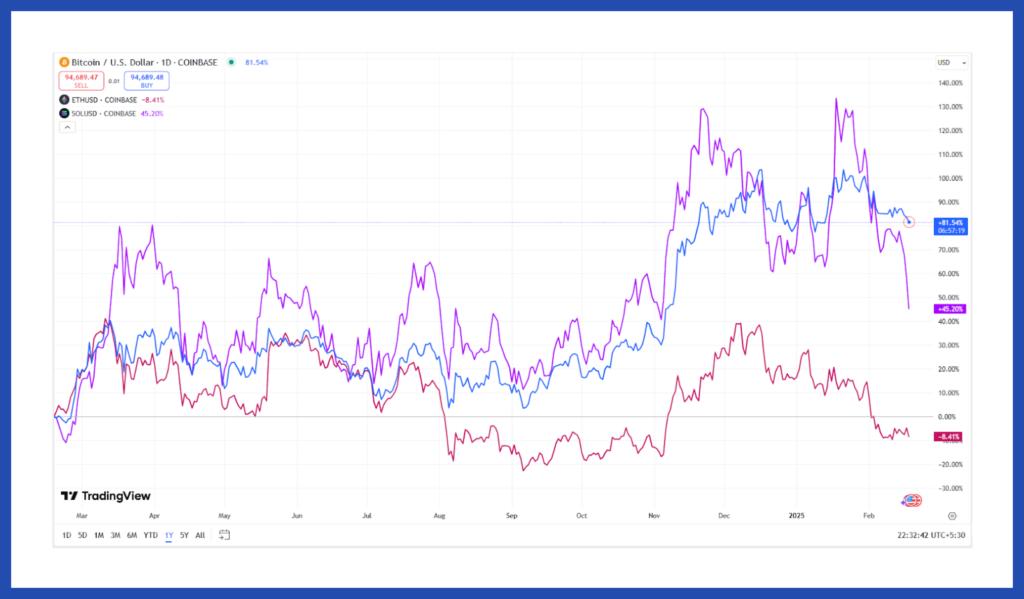The U.S. wants to be the world leader in crypto
Whether we like it or not, the Canadian crypto market depends heavily on what happens in the U.S. Not long ago—under the Biden administration—the U.S. government was ambivalent about bitcoin and crypto. Leading U.S-based crypto companies like Coinbase and Ripple (creator of the XRP cryptocurrency) faced heavy regulatory headwinds, and innovation in the industry was at a standstill.
However, with President Donald Trump taking office again—and having become a crypto advocate—it seems like the U.S. government is announcing new crypto-focused regulation weekly. Could these moves spur bitcoin (BTC) past $100,000 (all figures in U.S. dollars) again in 2025?
Here are the top five moves that Trump has made with regard to the crypto industry:
- U.S. Securities and Exchange Commission (SEC): The SEC is a key regulatory organization for crypto. Its incoming chair, Paul Atkins, is crypto-friendly. He said he intends to avoid heavy litigation against the crypto industry, in favour of a framework-setting approach.
- Bitcoin strategic reserve: The Trump administration is considering a bitcoin strategic reserve for the U.S. If it goes through with this, the U.S. would hold BTC as it does gold. This could be held on the balance sheet of the Federal Reserve (Fed), as gold is.
- Sovereign wealth fund: The Trump administration is also considering setting up a sovereign wealth fund—a state-owned investment fund—that could invest in bitcoin and other assets.
- White House AI and crypto czar: Czars seem to be all the rage in the White House these days. In December, Trump appointed David Sacks, venture capitalist, one-time COO at PayPal and former co-host of the All-In Podcast, as special advisor for AI and crypto. Sacks believes that new crypto-friendly legislation could be passed in as little as six months.
- Working Group on Digital Asset Markets: In January, Trump established a working committee whose aim is to “propose a Federal regulatory framework governing the issuance and operation of digital assets, including stablecoins, in the United States.” This committee is led by Sacks and includes major regulatory stakeholders like the secretary of the Treasury, the chair of the SEC and the attorney general, among others.
What’s happening with ethereum’s price in 2025?
Ether (ETH), the native cryptocurrency of the Ethereum platform, has grossly underperformed BTC over the past year, and ETH investors are understandably unhappy. As of Feb. 18, while BTC has risen about 80% over the past year, ETH is down 8%.
It doesn’t help that the Ethereum community has witnessed some online drama, with tussles over leadership changes at the Ethereum Foundation (EF). While Vitalik Buterin, the creator of Ethereum, wants to maintain control of personnel changes at the foundation, he’s facing pressure from those in the community who are unhappy with the current state of affairs. To be sure, EF does not centrally control ETH or its price. However, because it’s an important part of Ethereum’s community, trouble with EF negatively affects investor sentiment and contributes to negative price performance. And there’s another headache: increased ETH short positions by hedge funds betting against the cryptocurrency. Simply put, when you hold a short position on a cryptocurrency (or any other security), you’re adding downward pressure on the price. You’re betting on a fall in the price of the coin.
The pile up in ether shorts soared by a stunning 40% in one week to the highest on record. https://t.co/DL6ixY5JNm pic.twitter.com/5oUE7KmT6Q
— zerohedge (@zerohedge) February 7, 2025
It’s unclear whether ETH’s position as the second-largest cryptocurrency—by market capitalization—is under threat in the medium term. However, as this chart shows, ETH has struggled not just against BTC, but also against its biggest competitor, Solana (SOL).

The chart above shows that while BTC (blue) and SOL (purple) have gained 81% and 45%, respectively, over the past year, ETH (red) has lost over 6%.
Here’s another staggering figure: 42%. That’s how much ETH’s share of the total crypto market has fallen over the past year. In comparison, over the same period, BTC’s dominance has increased by 14.9% and SOL’s by 1.2%.
As a result of the 42% decrease in ETH’s dominance, its share of the total crypto market dropped below 10% for the first time since July 2021. As of Feb. 18, it sits at 10.3%.



















